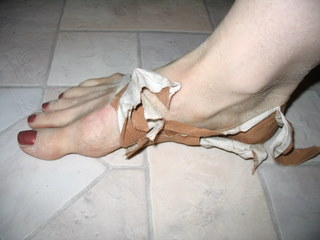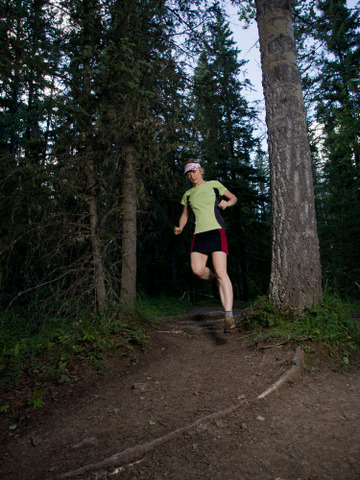Biomechanics

FYI, sports tape doesn't hold up to ocean/beach running!


To start, a caveat and disclosure.... I have no credentials in sports science. I am not a physio, chiro, sports doc, massage therapist, or acupuncturist. (That's not to say I haven't tried self-needling!)
What I do have is a small amount of experience with my own body and a keen interest in understanding everything I can about it. When I meet with a professional, I quiz them for information. I want to be part of the team of people who keep me running, so that means understanding muscles, ligaments, bones, proprioception, the endocrine system, and other factors impacting on human movement.
When I started running in 2006, up and down mountains in the snow, I surely didn't think I needed to do any "strength" work on my legs. I was proven very, very wrong when I ended up so injured with patella-femoral syndrome due to imbalances/weaknesses that I had to walk (hobble) near walls because my knees would give out on me. Prior to that, I had been putting various bands around my ITBs and taking copious quantities of anti-inflammatories. I thought that's just what ultra runners had to endure. Wrong again. But that was one I was glad to be wrong about.
My training programme now includes one to two days per week of strength training, including core (abs, low back, hips), glutes, and eccentric calf raises. I include some maximal and explosive strength work, depending on what I'm training for. I have added upper body work, which helps my posture and keeps my arms swinging after 20 hours or more. I have taken on the approaches of Chi Running (see the book/website/DVD). This is all done with a view of increasing strength, power, and muscular activation - enhancing endurance and delaying the fatigue (and resulting poor form) that comes with multi-hour/day racing.
I have weekly massage with a brilliant therapist who is also an athlete and works with athletes. I'd like to get away with fewer massages, but experience tells me repeatedly that I can't. I see a sports chiropracter every two weeks. When I go overseas, I find a local massage therapist and sports chiro. I use a foam roller, tennis ball, and The Stick. I also keep a training logbook that documents any concerns/pains (amazing what we can forget over time). I see a physiotherapist as needed. In 2014-2015, that might have been once. That's progress from 2006-2007!
I almost never take anti-inflammatories (NSAIDS). Not during races and never during training. First of all, painkillers mask the pain - they don't treat the underlying cause. If I have pain, I want to know about it, so I can fix the cause. Anti-inflammatories, in particular, slow down the healing process by inhibiting the production of prostaglandins. Prostaglandins create collagen. Collagen is our body's biggest protein and is found in tendons, ligaments, and muscles.
Suggestions for the injured:
So, when it has happened, I found solace in the following:
- staying hopeful because I know there is a cause to be found (and not generally accepting that it's just "too much mileage")
- staying involved with my running mates and the running scene. I have volunteered at events and read running blogs. I would meet my mates at their appointed run time and go walking while they ran, if I was in a walk phase of recovery.
- being proactive - trying to be ready with a plan - kayaking, swimming.... I set goals for these, as well. When off for surgery in 2009 and not allowed to cycle, I set two goals (1) develop 6 Pack Abs (didn't happen, but I did have a goal!) and (2) breaking my PB on an 8k paddle in my kayak. I also found the hand-crank ergometers at a local gym (like a bicycle but with arm power) and did 30 minute interval sessions for cardio.